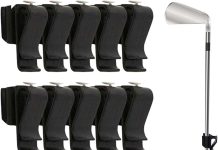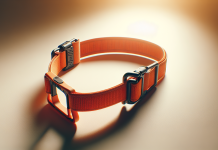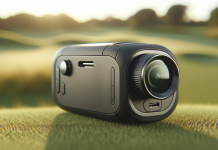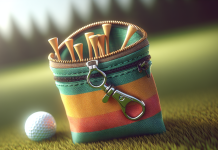? Have you ever wished for a simple, portable tool to help me keep my arms and body working together during every golf swing?
First impressions of the FINGER TEN Golf Training Aid Swing Trainer Aids Practice Equipment Smart Ball Arm Band Correcting Tool Accessories for Men Women
I felt encouraged by the promise of a straightforward solution to common beginner swing issues when I first saw the product. The packaging and the components looked organized, and I immediately appreciated that the trainer seemed designed for quick setup and frequent practice sessions.
FINGER TEN Golf Training Aid Swing Trainer Aids Practice Equipment Smart Ball Arm Band Correcting Tool Accessories for Men Women
What’s included in the box
I counted and checked each component as soon as I opened the package to make sure nothing was missing. The set is compact, and everything fits into a small bag or your golf bag pocket for practice on the range or even at home.
| Component | Quantity | Purpose |
|---|---|---|
| Inflatable Smart Ball | 1 | Helps maintain distance between forearms or under the armpits to reinforce proper connection |
| Adjustable lanyard | 1 | Attaches the Smart Ball between forearms or under the arms to control spacing |
| Elastic arm band (36cm x 7.2cm) | 1 | Keeps the arms connected to the body and trains straight-arm motion |
| Yellow PVC swing trainer | 1 | Provides an artificial hinge feel at the top of the backswing to promote correct hinge position |
| Instructions (paper) | 1 | Basic setup and recommended drills |
Design and build quality
I like that the materials feel durable without being heavy or cumbersome, which matters when you’re practicing for long sessions. The combination of elastic fabric, PVC, and an inflatable component gives me enough confidence that the trainer will hold up to repeated use.
The Smart Ball
The Smart Ball is inflatable and attaches via an adjustable lanyard so I can place it between my forearms or under my armpits depending on the drill. That flexibility means I can train different connection points and sensations, which helps reinforce the right muscle memory.
The Arm Band
The arm band is made of elastic fabric and measures 36cm by 7.2cm; it stretches comfortably and snaps back without losing shape. I found it comfortable against the skin and secure enough that I didn’t worry about it sliding during swings.
The Yellow Swing Trainer
The yellow swing trainer is a lightweight PVC piece designed to give me a sense of the correct hinge at the top of my backswing. It’s not heavy, so it won’t change my swing weight much, but it provides a tactile cue that helps me recognize when my arms are in the right position.
How I set it up
I appreciated that there was no special tool needed; inflation and attachment were straightforward. In under five minutes I had everything adjusted to my preferred tightness and placement for a practice session.
Inflating and adjusting the Smart Ball
I used a small hand pump to inflate the ball to a pressure that felt firm but comfortable between my forearms. The adjustable lanyard made it easy to customize the spacing so the ball stayed put without restricting natural motion.
Fitting the arm band
I slid the elastic arm band over my forearms and adjusted it until it felt snug but not restrictive. The band’s elasticity let me move my arms through a full range of motion while still providing the cue to keep the arms connected.
How it feels to use
The first swings felt unusual because the trainer forces a connection I often forget to maintain when I get aggressive with my hands. After a few repetitions, I felt my arms and torso working together more consistently and noticed a smoother path through impact.
Putting my body and arms in sync
I noticed that when the Smart Ball or arm band is in place, it’s almost impossible to excessively separate my arms from my body, which corrected a flippy or hands-first motion. That immediate feedback helped me adjust my tempo and maintain a fuller shoulder turn.
For right- and left-handers
I tested the setup for both right- and left-handed stances by switching the placement and found the gear equally usable for either hand. The adjustability of the lanyard and the flexible arm band design mean there’s no need for separate left- or right-specific hardware.
Training drills I used
I structured my practice into short, focused drills that targeted connection, hinge, impact, and tempo. Each drill took only a few minutes and the simplicity of the gear made it easy to switch between drills without losing momentum in my practice.
Connection drill: Forearms together
I placed the Smart Ball between my forearms and made slow half-swings, focusing on keeping the ball stable and maintaining a consistent distance. This drill trained me to resist collapsing the lead arm and to feel the correct relationship between my arms and torso.
Armpit drill: Ball under the armpits
I positioned the Smart Ball under both armpits and made slow swings to feel my chest and shoulders turning together. That placement encouraged me to use my torso rather than my hands to create swing power.
Arm band drill: Straight-arm path
Wearing the elastic arm band, I practiced smooth swings, concentrating on keeping my trail arm relatively straight on the takeaway. The band reminded me not to break my lead arm too early in the swing, which improved my consistency through impact.
Top-of-swing hinge drill: Yellow trainer focus
I used the yellow PVC swing trainer to get a physical feel for the correct hinge at the top of my backswing. By stopping at the top and checking the hinge position, I built better awareness of where my wrists should be at transition.
Impact training: Slow motion to full speed
I began with slow-motion swings using the ball or band, then progressively increased speed while maintaining connection cues. This gradual tempo build helped me transfer the correct positions into more realistic, faster swings without reverting to old habits.
Results after practice
After several sessions using the set, I noticed more consistent contact and fewer outside-to-inside swings. My first immediate improvement was a reduction in casting and a cleaner compression through the ball.
| Week | Focus | Observable improvement |
|---|---|---|
| 1 | Basic connection drills | Reduced arm separation; better feel for forearm spacing |
| 2 | Hinge and impact drills | More consistent top-of-swing hinge; fewer flipped wrists |
| 3 | Tempo and full-speed swings | Increased ball compression and steadier ball flights |
| 4 | Performance integration | Habitual arm-body connection carried over to on-course play |
I used the weekly breakdown to track the incremental gains and to remind myself not to rush the process. The improvements were modest but measurable, especially when I recorded my swings and compared before/after frames.
Pros and cons
I think this trainer set offers a lot of value for a low price, but it has limits compared to more advanced or electronic trainers. Below I balanced what I liked and what held me back during the testing period.
Pros:
- I found the kit easy to use and portable for range or home practice.
- The Smart Ball gives clear tactile feedback that quickly corrects excessive arm separation.
- The elastic arm band promotes muscle memory for connected swings without being uncomfortable.
- The yellow trainer provides a useful hinge cue for the top of the backswing.
- Suitable for both right- and left-handed golfers and especially helpful for beginners.
Cons:
- I noticed the Smart Ball can shift slightly during higher-speed swings if not inflated or lanyard-adjusted properly.
- For advanced players with subtle swing faults, the tool’s feedback might be too blunt to refine fine timing issues.
- The arm band might feel redundant when used simultaneously with other training aids, depending on your drill.
- The PVC hinge trainer shows you the feeling but doesn’t replace video feedback or professional coaching.
Who should buy it?
I think beginners and high-handicap golfers who struggle with arm-body connection will get the most immediate benefit from this product. I also recommend it to instructors who want simple tools to give students tactile reminders during lessons.
How it compares to similar products
I compared this set to simple single-piece arm bands and to weighted swing trainers to understand where it fits in the market. The FINGER TEN kit sits in the middle ground between tactile connection tools and mechanical swing devices.
Compared to simple arm bands
Compared to plain elastic arm bands, this kit adds the Smart Ball and the PVC hinge trainer, which provide additional training sensations. I found that combination more effective for teaching multiple aspects of the swing than a single arm band alone.
Compared to weighted trainers
Weighted trainers are designed to build strength and tempo, but they sometimes mask technique flaws by forcing the body to power through. I liked that the FINGER TEN set emphasizes positional awareness and muscle memory without significantly changing swing weight.
Maintenance and durability
I treated the pieces gently and stored them in a dry place, and they held up well after multiple practice sessions. The materials are resilient, but I recommend checking the Smart Ball’s inflation before every session and keeping the elastic band out of prolonged direct sunlight.
Tips and common mistakes
I learned a few practical tips and also observed common mistakes that can reduce effectiveness if ignored. Paying attention to proper setup and clear drill goals speeds up learning and prevents frustration.
Tips:
- Always start with a firm but comfortable inflation for the Smart Ball; too soft and it won’t give a cue, too hard and it’ll feel awkward.
- Spend time doing slow, purposeful swings before adding speed; muscle memory forms best with controlled repetitions.
- Record your swing occasionally so you can verify that the sensation translates to visible improvement.
- Switch between ball between-forearms and under-armpits placements to train different aspects of connection.
Common mistakes:
- Over-tightening the lanyard so it restricts natural rotation; that prevents the body from turning and teaches the wrong sensation.
- Using the device for long sessions without focused intent; repetitive bad practice will reinforce faults rather than fix them.
- Assuming instant perfection; consistent incremental practice is what produces lasting changes.
Safety notes
I always recommend a careful warm-up before using any training aid to reduce the risk of strain. If you feel unusual pain or discomfort while using this device, stop and reassess placement, tension, or consult a coach or medical professional.
My final verdict
I found the FINGER TEN Golf Training Aid to be an approachable, effective kit for developing better arm-to-body connection and hinge awareness. If I had to sum it up, I’d say it’s a practical, low-cost set that delivers clear feedback for beginners and recreational players who want tangible improvement without complicated technology.
Frequently asked questions (FAQ)
Is this trainer suitable for absolute beginners?
Yes, I think it’s very beginner-friendly because the tactile feedback is immediate and easy to understand. I recommend starting with very slow swings to build the correct sensations before increasing speed.
Can I use this on the course or only on the range?
I used the set on both the range and for practice swings on the course before a round. Be mindful of using it in crowded areas; it’s best for individual practice or warm-ups.
Will this change my swing weight or timing?
The components are light and don’t significantly alter swing weight, but they do alter timing by forcing connection and a more coordinated turn. I noticed my tempo improved because I focused on body-driven rotation rather than hand actions.
How long before I see improvement?
I saw small improvements within the first week of focused practice and more consistent changes after two to four weeks. Results vary by individual commitment and how accurately the drills are practiced.
Can advanced golfers benefit from this?
Advanced golfers can use it to reinforce fundamentals or to address a specific issue like casting or breaking the lead arm. However, the tool is most impactful for those who need clear, blunt cues rather than fine-tuning.
How do I clean and store the components?
I wiped the band and PVC trainer with a damp cloth and mild soap when needed, and I deflated the Smart Ball slightly for compact storage. Keep everything dry and away from prolonged sunlight to maintain elasticity and plastic integrity.
Is it adjustable for kids or smaller adults?
The adjustable lanyard and elastic band accommodate a range of body sizes, though for very young children the fit might be less precise. I tested it on different adult body types and found the adjustments more than adequate.
Practical practice plan I followed
I created a simple weekly plan to use the kit effectively and to keep practice focused and measurable. This plan kept me accountable and prevented me from using the tool mindlessly, which I’ve seen happen with less structured training.
Week 1: Connection foundation
- 10 minutes daily focusing on forearm ball placement and slow half-swings.
- Emphasis on feeling the distance and preventing arm separation.
Week 2: Hinge and impact
- 15 minutes on top-of-swing hinge using the yellow PVC trainer and slow impact-focused reps.
- Combine with armpit placement for full torque awareness.
Week 3: Tempo and speed transfer
- 20 minutes alternating slow-motion and gradually faster swings while maintaining connection.
- Use a mix of ball and band placements.
Week 4: On-course integration
- Warm-up with the trainer before rounds and perform targeted range sessions once or twice weekly.
- Record a few swings and compare to early-week videos to confirm progress.
I tracked small metrics like contact quality, ball flight consistency, and subjective feel to keep motivation high.
My coaching notes (what I would tell a student)
When I coach someone using this trainer, I focus on three simple cues that the tool reinforces: keep the elbows connected to the torso, maintain a firm but not rigid forearm spacing, and hinge at the top with a feeling of coil. I encourage patience and short, deliberate practice sets rather than marathon sessions.
Common swing faults this trainer helps fix
From my experience, the trainer addresses these typical errors effectively:
- Early arm separation that causes slicing or weak shots.
- Casting or flipping of the wrists through impact.
- Poor hinge awareness leading to a lack of consistent top-of-backswing position.
- Overuse of hands rather than the torso to generate power.
Real-world use cases
I used the trainer for warm-ups, focused range sessions, and as part of rehabilitation practice when I was working through a grip or swing plane adjustment. It proved useful as both a teaching aid and a muscle-memory tool that I could rely on for consistent sensations.
Price vs. value assessment
Given the low cost compared to high-tech swing analyzers, I felt the FINGER TEN kit offered excellent value for basic fundamental training. I’d rate it highly for those who want physical feedback without paying for electronics or extensive coaching sessions.
My recommended setup for maximum benefit
I recommend starting with the Smart Ball between the forearms for connection, then alternate to under the armpits to reinforce torso involvement, and finally use the arm band and PVC hinge trainer to lock in the top and impact positions. I also suggest short sessions focused on a single drill to avoid scattershot practice.
Summary of key takeaways
I found the product to be a practical, effective aid for building connection and hinge awareness in a beginner-friendly package. With consistent use and focused drills, the kit helped me form better muscle memory and led to more reliable ball contact and smoother swings.
If you’d like, I can outline a personalized four-week training schedule tailored to your current swing tendencies and goals, or walk through some video examples I used to monitor my progress.
Disclosure: As an Amazon Associate, I earn from qualifying purchases.







































